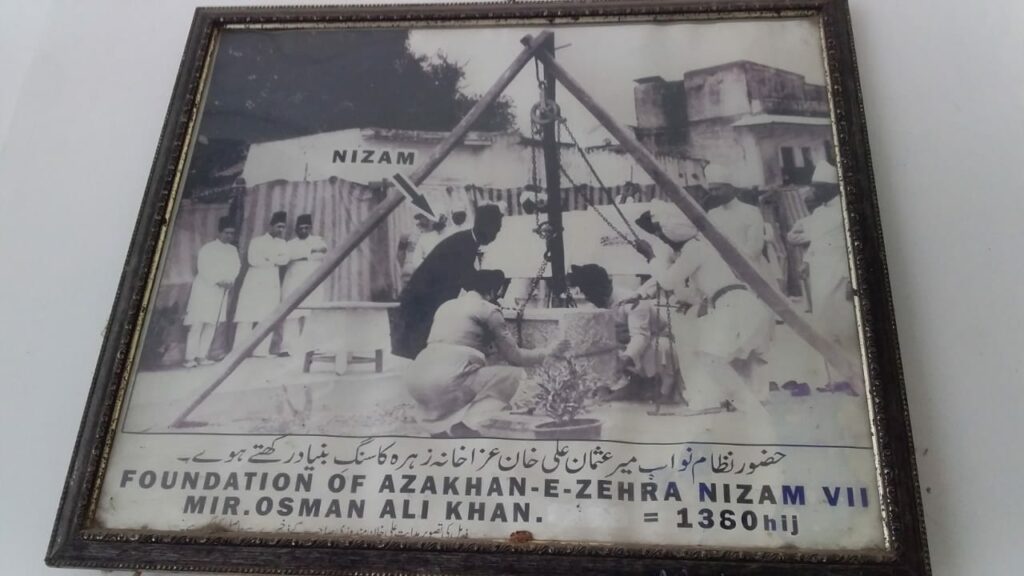By Sana Sikander
Hyderabad: Monuments always stand as an aide-memoire of history and Ashur Khanas in Hyderabad too marked their recognition.
Soaked in the aura of Nizam’s magnificent dynasty and shaded with the reverence of maternal endearment, Aza Khana-e-Zehra stands as the epitome of love and bemoan.
The historical architecture symbolises Nizam Mir Osman Ali Khan’s regard for his mother Amtul Zehra Begum also known as Madar-e-Deccan (Mother of Deccan). The monument is used by the Shia community of Muslims for mourning the death of Imam Hussain Ibn Ali in the battle of Karbala.
Though the Nizam himself was Sunni, he commissioned this appealing building for his mother who was Shia, thus communicating how religious barriers were once indisputably blended in Hyderabad.
Despite owning a region of 86,000 square miles of the princely state, Nizam had chosen the land at the northern bank of Musi (now Dar-ul-shifa) for the construction of this Ashur Khana, noting its potential to withstand Thughyani Sithambar – the Great Musi Flood which occurred on 1908 and killed 50,000 people. Though it washed away the three bridges – the Afzal, Musallam Jung and Chadeghat – the Puranapul survived the flood to become the only link between two parts of the city. Amjad Hyderabadi, an Urdu poet was one of the 150 people who saved their lives by hanging on the branches of a Tamarind tree, which till date, 107 years after the incident stands strong in the Osmania Hospital.
Since the land, now adjacent to Salarjung Museum, pulled through the torrent, Nizam laid the foundation of the Aza Khana-e-Zehra, on it, in 1930.

As one enters the heavily built structure, a massive space of estimated 4,500 square yards is the first view. The hall can accommodate 25,000 people, usually mourners. The teak rafter ceiling 45-feet high without supporting pillars exhibits robustness of establishments made during Nizam’s dynasty.
With sheer delicacy of design, the walls are ornately crafted with light green and yellow colors on them, beaming throughout the hall. Artistic calligraphy of Quranic verses are positioned on the walls. The upper story of the building is beautified with exquisite yet sturdy Jaali for women mourners.

The intricate chandeliers made of glass showcase the indulgence of royalty. The chandeliers are rarely lighted and mostly during the days of Ashura – the 10 days of Islamic month Muharram in which Shia Muslims around the world commemorate the mourning custom over the death of Hussayn Ibn Ali.

Then, comes the most dominant element of the Ashur Khaana – The Alams! Made of gold and studded with diamonds, Alams are the integral unit of the mourning place, the symbolic representation of the martyrs who died in the Battle of Karbala. These are heavy metals filled with intricate figurines and engraving. In the centre of the Alam stands the Tique, a long sword-like structure engraved with poetry about Hussain Ibn Ali, the names of the prophet Muhammed and his children, and verses from the Holy Quran.
The Alam has a variety of figurines, including lions, birds, flying horse, dragon etc. each symbolising a story.
Dhatti,a gesture of respect towards martyrs is offered by the representative of the Nizam family and others.
Syed Ali Naqi Moosavi, General Secretary of Tanzeem-e-Jafferi says: “Alam means a flag and ideology of symbolising the martyrs has turned into tradition now”
Aza Khana-e-Zehra was conferred the Intach Heritage Award in 1999. Telangana comprises 11,000 Ashur Khanas, many of which are being maintained by Hindus.

